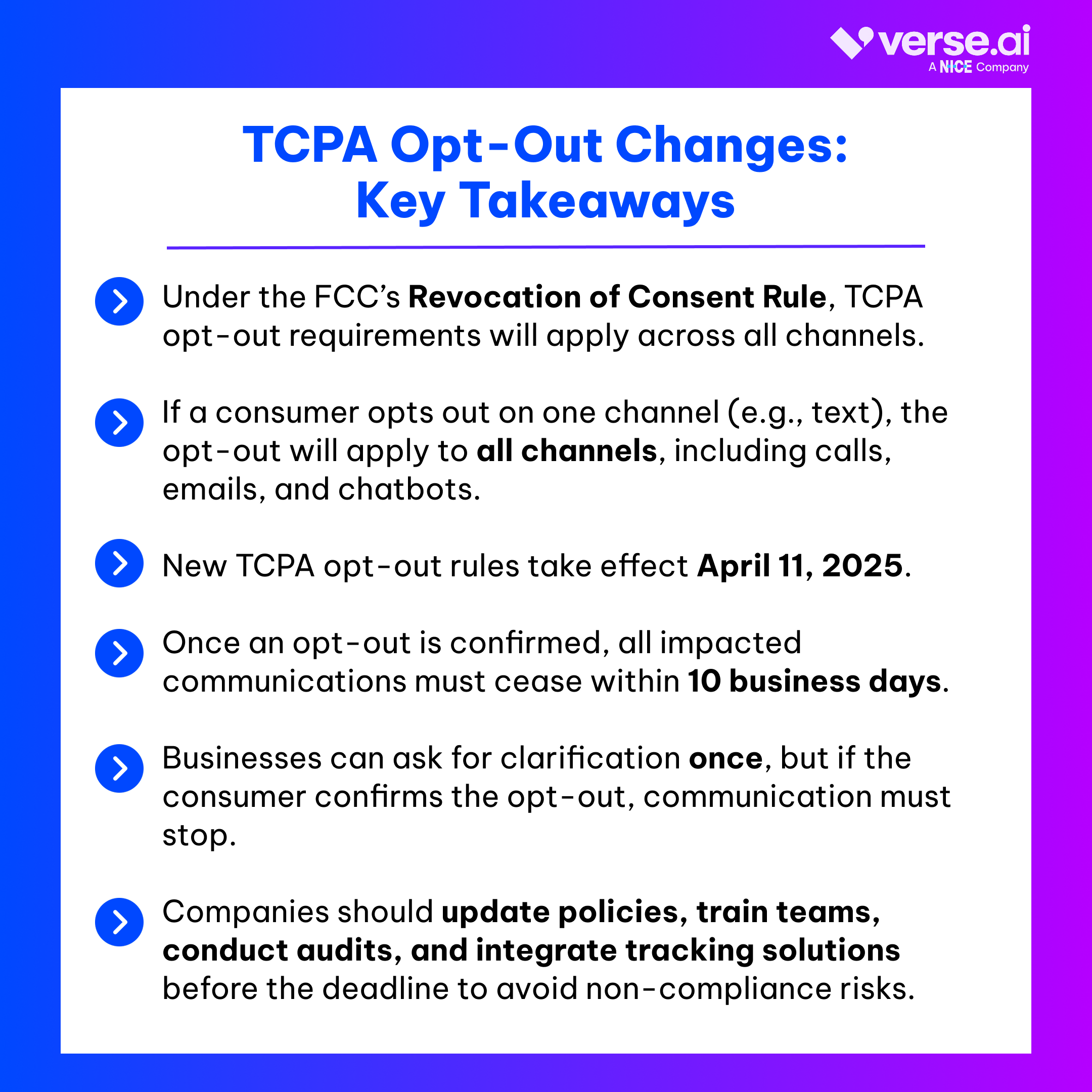FCC issues significant updates to TCPA under Revocation of Consent Rule
You’ve likely heard of the Telephone Consumer Protection Act (TCPA)—but did you know that TCPA opt-out requirements will soon be expanded?
The Federal Communications Commission (FCC) recently updated its TCPA Revocation of Consent Rule, which will affect opt-outs for business calls and texts.
Starting April 11, 2025, there will be key changes to TCPA compliance, including stricter opt-outs across all communication channels.
What does this mean exactly? Let’s talk about what the new TCPA opt-out requirements under the Revocation of Consent Rule mean in practical terms, including answers to frequently asked questions.
Important update as of April 8th, 2025:
The Federal Communications Commission (FCC) has recently announced a one-year delay in the implementation of a specific provision within its new Telephone Consumer Protection Act (TCPA) revocation rules. This delay grants businesses additional time to adjust their compliance strategies accordingly.
The provision affected by this delay is found in 47 C.F.R. § 64.1200(a)(10). Originally set to take effect on April 11, 2025, this rule mandates that if a consumer revokes consent to receive robocalls or robotexts in response to one type of message, that revocation must apply universally to all future communications from that caller, regardless of the subject matter.
The FCC has postponed the enforcement of this specific requirement until April 11, 2026, citing the need to provide businesses, particularly those in the financial and healthcare sectors, with adequate time to develop and implement systems capable of processing such broad revocation requests efficiently and cost-effectively.
What remains on schedule:
Despite the delay of the cross-channel consent revocation provision, other components of the TCPA revocation rules are still slated to become effective on April 11, 2025.
These include:
- Revocation through any reasonable means: Consumers retain the right to revoke consent using any reasonable method that clearly expresses their desire to opt out of future communications. This includes, but is not limited to, replying to texts with standardized keywords such as “stop,” “quit,” “end,” “revoke,” “opt out,” “cancel,” or “unsubscribe”.
- 10-day compliance window: Businesses are required to honor revocation requests within 10 business days of receipt, a significant reduction from the previous 30-day window.
- Clarification messages: Upon receiving a revocation request, businesses are permitted to send a one-time confirmation message to clarify the scope of the opt-out. This message must be sent within five minutes of the revocation request and must not contain any marketing or promotional content. If the consumer does not respond to this clarification message, the revocation applies to all communications from the sender.
TCPA overview
Under U.S. federal law, telemarketing calls and text messages are regulated under the Telephone Consumer Protection Act (TCPA).
It requires:
- Written consent for all autodialed or prerecorded telemarketing calls to wireless numbers and residential lines.
- That businesses obtain written consent before sending text messages and clearly disclose that the recipient will receive future text messages.
- That companies provide a clear way to opt-out in their initial message and subsequently every 30 days.
For basic TCPA compliance, companies should:
- Provide compliant opt-in forms that collect prior express written consent before calling or texting consumers.
- Protect consumer data.
- Provide clear and functional opt-outs.
With the Revocation of Consent Rule, TCPA opt-out requirements have become more stringent.
New TCPA opt-out requirements
The FCC’s new updates to the TCPA opt-out requirements are intended to reinforce consumer rights.
To comply with the new TCPA Revocation of Consent Rule, businesses must honor opt-out requests across all communication channels, regardless of original consent scope.
In addition:
- Companies have only one chance to clarify a message to preserve consent.
- If opt-out is confirmed, businesses then have 10 business days to cease communication.
-
Replying to a text message (SMS/MMS)
-
Phone calls to customer support (live agent or IVR)
-
Sending an email
-
Filling out a website contact form
-
Messaging through a chatbot
-
Communicating in person or during a customer service interaction
The Revocation of Consent Rule is set to go into effect April 11, 2025.
How the Revocation of Consent Rule changes the TCPA
The key change that this rule makes to the TCPA involves the treatment of opt-out requests.
TCPA revocation applies to automated telemarketing communications, not email or manual dialing (unless those also use automation).
The FCC’s new ruling is about making it easier for consumers to revoke consent for robocalls and robotexts, and ensuring businesses honor that revocation regardless of how it’s received.
It doesn’t touch email, live-agent calls, or broader marketing practices.
Once an opt-out is received, businesses have ten business days to stop all impacted communications across all channels enterprise-wide. This requires robust tracking and suppression mechanisms.
This massively expands the scope of how opt-out requests must be treated under the Telephone Consumer Protection Act (TCPA).
Why the FCC created the Revocation of Consent rule
The core principle of the change is that consumers who have previously consented to receive autodialed or prerecorded calls and texts can revoke that consent through any reasonable means.
This reaffirms a long-standing common law right and aims to empower consumers to control unwanted communications.
The FCC seeks to clarify what constitutes a “reasonable means” of revocation to benefit both consumers and callers and ensure revocation requests are adequately honored.
How to prepare for the Revocation of Consent rule
To prepare for the ruling, businesses should act now.
By April 11, 2025, businesses should have a strategy for identifying, ingesting, and disseminating revocation of consent requests.
They should also:
- Update policies to reflect new compliance requirements.
- Ensure that robust tracking solutions are in place to ensure opt-outs are carried out across channels within 10 days.
- Move to identify and remediate fractured communications between data systems that may thwart free flow of revocation information.
- Obtain legal guidance from outside counsel as needed to assess compliance.
To ensure full compliance, businesses should also conduct an internal compliance audit to identify any vulnerabilities.
To limit opt-out requests, develop or revisit communication strategies that prioritize high-value communications.
Please note that this is not legal advice, just tips to help you better prepare.
What counts as an opt-out?
The FCC does not mandate that companies provide a specific method, such as reply texts, for revoking consent.
However, it acknowledges that reply texts are a reasonable and widely recognized way to revoke consent.
For SMS, the words “stop,” “quit,” “end,” “revoke,” “opt out,” “cancel,” or “unsubscribe” are considered a per se reasonable means to revoke consent.
These words are widely recognized as industry standards that automated systems can readily process to honor opt-out requests.
However, the FCC acknowledges that other words and phrases can also effectively revoke consent.
If a dispute arises, the sender of the texts will have the opportunity to argue why the consumer’s alternative wording is not a reasonable means of revocation.
Ultimately, the FCC or a court will conduct a “totality-of-the-circumstances” analysis to determine if the intent to revoke consent was reasonably conveyed.
For this reason, it’s best to have robust methods in place to ensure that if a consumer is trying to opt-out, this request is received and processed.
This includes that automated systems are overseen and programmed properly.
If a company uses a texting protocol that doesn’t allow reply text, it must disclose this limitation in each text message and provide reasonable alternative ways to revoke consent, such as a phone number, website link, or instructions to text a different number.
Revocation of Consent via voicemail or email
If a consumer revokes consent via voicemail or email to a number or address reasonably expected to reach the caller (but not designated by the caller as an opt-out method), it creates a rebuttable presumption that they have revoked consent.
If there is a dispute, it will be evaluated by the FCC or a court using the “totality of the circumstances” test.
Revocation of Consent in-person
Consumers can opt-out verbally as well.
In this case, businesses must acknowledge, document, and process verbal opt-out requests, ensuring the consumer is removed from marketing lists right away.
Confirmation of opt-out
The company can send a one-time confirmation text to clarify whether a consumer wants to opt out of all categories of messages or only some.
If there is no response, the company must treat it as a revocation of consent for all robocalls and robotexts.
A “STOP” or similar text sent in response to the one-time request for confirmation does not allow the text sender to send another request for further clarification.
Revocation of Consent Rule: FAQ
What are the new TCPA opt-out requirements?
The FCC’s new rule requires businesses to honor opt-out requests across all communication channels, not just the one where consent was revoked.
It also mandates that businesses stop all impacted communications within 10 business days of receiving an opt-out.
When does the Revocation of Consent rule go into effect?
The Revocation of Consent Rule goes into effect on April 11, 2025. Businesses must comply with the updated TCPA opt-out requirements by this date.
How can companies prepare for the Revocation of Consent rule?
Here are a few things businesses can do:
- Update internal policies and training to reflect new opt-out requirements.
- Implement a tracking system to manage opt-outs across all communication channels.
- Ensure all teams and systems handling consumer interactions can process opt-out requests properly.
- Conduct a compliance audit to identify gaps and potential risks.
- Seek legal guidance if necessary to ensure full TCPA compliance.
Under the new rule, how many opportunities does a business have to preserve consent?
Businesses will only have a single chance to use a “clarification” message to preserve consent, so they must carefully craft and implement their clarification strategies.
Are previously exempted messages still automatically exempt under the new TCPA rules?
No. Even messages exempted from the TCPA may now be revoked under certain circumstances, requiring a reevaluation of exemption strategies and practices.
How quickly must businesses act on an opt-out request under the new rule?
Once an opt-out is received, businesses have ten business days to honor the opt-out across channels.
Can a consumer opt-out verbally?
Yes. Businesses must acknowledge, document, and process verbal opt-out requests, ensuring the consumer is removed from marketing lists right away.
What methods are considered per se reasonable for revoking consent via text message?
Using the words “stop,” “quit,” “end,” “revoke,” “opt out,” “cancel,” or “unsubscribe” in a reply text message is considered a per se reasonable means to revoke consent. These words are widely recognized as industry standards that automated systems can readily process to honor opt-out requests.
How quickly must callers honor revocation of consent requests?
Callers must honor company-specific do-not-call and revocation-of-consent requests no later than ten business days after receiving the request.
If a customer has elected to receive multiple types of informational texts, but then revokes consent, can a company still send a confirmation text?
Yes, under certain conditions. The company can send a one-time confirmation text to clarify whether the customer wants to opt out of all categories of messages or only some.
However, if there is no response, or the customer replies with STOP or a similar text: the company must treat it as a revocation of consent for all robocalls and robotexts.
TCPA opt-out changes under Revocation of Consent: Key takeaways



